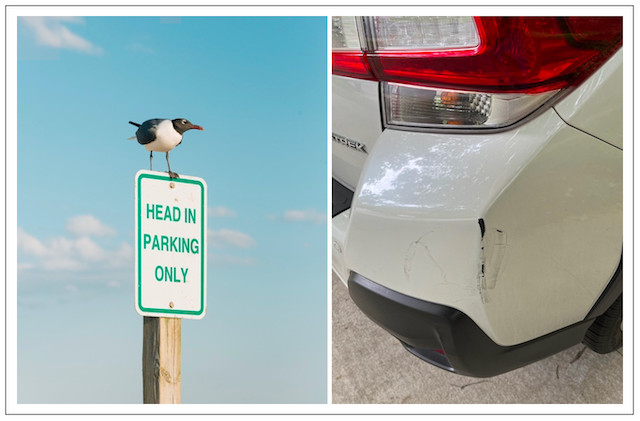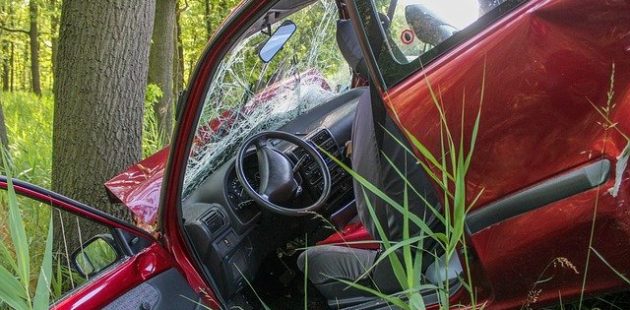Missing the Point – Signs of the Times?
I’ve long suspected that we, as a society, are not entirely sure whether we’re coming or going. Now I have proof.
You don’t have to be a hyper-observant writer to have noticed the substantially increased frequency with which people are backing into shopping center parking lot spaces.
Why are they doing this? Backing into their parking spaces, that is? Presumably, it’s so that they can leave their parking spaces by going forward, instead of having to back out on their way home, into people and cars coming from and going to their own parking spaces. … Isn’t it six of one, half a dozen of the other? You drive head-in and then back up to get out? Or vice versa? What difference does it make?
And why now? Why is this a thing all of a sudden? If it’s preferable and if it really makes better sense, why haven’t people been doing this all along? The simple answer is that these “backup people” have been newly empowered by the advent of rear-facing cameras and proximity sensors. They believe their time has come.
Now, tell the truth. How many of you reading this and who have relatively new cars with cameras and sensors are still backing up the old-fashioned way? You know, by looking over your shoulder, past your headrest, and around the blind spots from whatever’s holding up the roof of your car? Or, like me, are you depending increasingly on the screen in the center of your dashboard to show you what’s really going on back there?
I confess, when I pull into my parking space, head-in, if the space in front of me is open, I pull through. Because driving out head-first is easier and probably safer.
So, what am I complaining about? It’s a free country. Why shouldn’t people back into their parking spaces if they want to? Because parking spaces are small and backup cameras and sensors don’t generally watch the front and back of your car simultaneously! That’s why!!
Do you see that scrape on the rear bumper of the car in the featured image? That’s my car which, until recently, was dent and scrape-free. It was perfect. Not anymore. I pulled into the Giant Food parking lot, head-in as I usually do, being careful to center my car in my space and not to open my door too wide and risk dinging the car next to me. I do this out of respect for the larger car next to me even though my size 12 shoes sometimes get stuck squeezing out of my partially open car door — and because leaving through the sunroof isn’t really an option.
When I was done shopping, there it was – undoubtedly, the result of some car next to me backing into its space while I was gone. There’s no dent, just a scrape. A scrape that the body shops I’ve surveyed want from the high $700s to just over $1,000 to fix – unless I want to buy a touch-up kit and do it myself which I don’t want to do. The high estimates have something to do with having to remove, paint, and then replace bumper panels.
Yes, I have insurance. It’s with the company that has the tiny lizard for its mascot. Apparently, I’ve had an “unoccupied vehicle incident” which falls under the heading of “uninsured motorist property damage.” According to my insurance company, filing a claim for this type of “accident” will have zero impact on my policy because it doesn’t reflect my skill as a driver. It will, however, be subject to a $250 deductible.
So, because some driver who parked next to me – and may not even have known that his or her car brushed up against mine – I’m out of pocket $250 and insurance rates overall will be adversely affected by this new category of incidental damage. Multiply the impact on accident statistics by how many zillions of times this is happening every day, and the total effect is not insignificant. It’s a smallish, but readily avoidable problem.
Even if you have one of those cars that gives you a 360-degree, bird’s eye, live video of your immediate surroundings, it’s not easy allocating your vision between the screen in the center of your console and the windows around your car. Depending upon the size and position of your car and the cars on either side of you and how fast you’re moving – pressures being what they are to get out of the way of people and cars you’re holding up – it takes experience and skill to back into a parking space just right.
And if you, like me, have a car with only a rear-facing camera and sensors, and not the 360-degree view, it’s even harder.
Shopping center parking spaces range from 7.5’ to 9.0’ wide. The typical car is 5.8’ wide. That leaves only 1.7’ to 3.2’ total, on both sides of your vehicle, to turn into the space and for opening your doors when you get out of your car. That’s not a lot of wiggle room.
Some developers put double lines between parking spaces to help us out. Others use diagonal parking which rules out backing into spaces altogether. And some centers just post “Head In Parking Only” signs which most shoppers respect.
I wonder … Do these compulsive, back-in drivers back down their driveways and into their garages at home? I hope not, although it could result in a major boon to the residential structural repairs business.
Do they “moonwalk” backward into restroom stalls and walk-in closets?
In any case, notwithstanding the potential for backing-in collisions, there are other considerations. No less an authority that the American Automobile Association claims that driving nose out of your parking space when you leave is safer. This is apparently because your eyes are on the front, face-side of your head which rotates – the way my headlights move when I turn my steering wheel. How cool is that?
You would think that the same wide-angle, rear-facing camera and hard-stop, automatic rear-breaking sensors would help you back out of your space, even more so than they do backing in. And then there is the serious problem of how and when any driver should share his or her time and vision between looking out the windows of the car and at the larger and larger screens in the centers of our dashboards. Until someone figures that out for us, I’m going stay with parking my car head-in.

Les Cohen is a long-term Marylander, having grown up in Annapolis. Professionally, he writes and edits materials for business and political clients from his base of operations in Columbia, Maryland. He has a Ph.D. in Urban and Regional Economics. Leave a comment or feel free to send him an email to [email protected].


